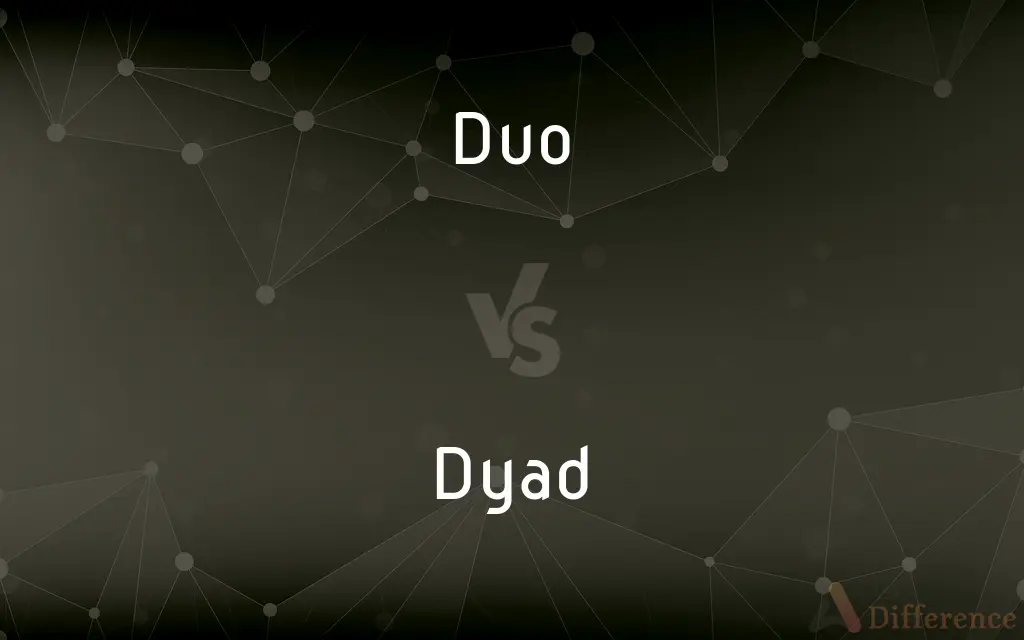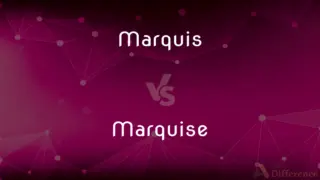Duo vs. Dyad — What's the Difference?
By Tayyaba Rehman & Urooj Arif — Updated on March 28, 2024
A duo refers to two people performing together or associated with each other, often in music or entertainment, while a dyad encompasses any two entities (people, objects, or concepts) in a relationship or pairing, highlighting their interconnectedness.

Difference Between Duo and Dyad
Table of Contents
ADVERTISEMENT
Key Differences
A duo primarily denotes a pair of individuals collaborating or performing together, especially in the context of music, arts, or entertainment. This term emphasizes their partnership in a specific activity or field. In contrast, a dyad refers to any two entities engaged in a relationship, focusing on the dynamic and interaction between them, regardless of the context. This can apply to social sciences, psychology, and beyond, where the analysis of relationships is central.
While a duo is often seen in a positive light, signifying harmony and collaboration, a dyad can encompass a wider range of interactions, including conflictual or competitive dynamics. The term dyad is used to analyze the nature of the relationship itself, beyond just the collaborative aspect seen in duos.
In practice, a musical group consisting of two people would be described as a duo, highlighting their artistic collaboration. On the other hand, when studying the interpersonal dynamics between two individuals, researchers might refer to them as a dyad to focus on the complexities of their interaction, whether they are co-workers, friends, or rivals.
The use of duo is more common in everyday language, particularly when referring to famous pairs or partnerships in entertainment and other fields. Dyad, however, is more frequently used in academic, psychological, and sociological contexts to discuss theories of human interaction and relationships.
The distinction between duo and dyad also reflects their applicability: duo is used more specifically to denote a partnership with a shared goal or activity, while dyad serves a broader analytical purpose, examining the nature of two-way relationships across various contexts.
ADVERTISEMENT
Comparison Chart
Definition
Two people performing together or associated in a specific context.
Any two entities (people, objects, concepts) in a relationship.
Context
Music, arts, entertainment
Social sciences, psychology, relationships
Emphasis
Collaboration, partnership
Interaction, relationship dynamics
Usage
Common in everyday language
More common in academic and analytical contexts
Range of Dynamics
Primarily positive and collaborative
Includes all types of interactions (positive, negative, neutral)
Compare with Definitions
Duo
Used to describe two people famous for working together.
The director-actor duo has produced several blockbuster movies.
Dyad
Applicable in social sciences and psychology.
Researchers examined the conflict resolution strategies within managerial dyads.
Duo
Often related to music, entertainment, or arts.
The comedy duo became famous for their witty sketches.
Dyad
Encompasses a broader range of interactions than duo.
The policy dyad influenced both local economies and international relations.
Duo
Focuses on the collaborative aspect of the relationship.
As a teaching duo, they created an innovative curriculum for their students.
Dyad
Any two entities in a significant relationship.
The therapist explored the dynamics of the parent-child dyad in their sessions.
Duo
A pair of individuals collaborating in a performance or activity.
The jazz duo captivated the audience with their harmonious performance.
Dyad
Can refer to concepts or objects in relation to each other.
The book delves into the dyad of tradition and modernity in urban development.
Duo
Implies a partnership with a shared goal.
The investigative duo worked tirelessly to solve the mystery.
Dyad
Used in analyzing the nature of two-way relationships.
The study focused on the dyad formed by mentor and mentee interactions.
Duo
A pair of people or things, especially in music or entertainment
The comedy duo Laurel and Hardy
Dyad
Two individuals or units regarded as a pair
The mother-daughter dyad.
Duo
A duet
Two duos for violin and viola
Dyad
(Biology) One pair of homologous chromosomes resulting from the division of a tetrad during meiosis.
Duo
(Music) A duet, especially two performers singing or playing together.
Dyad
A function that draws a correspondence from any vector u to the vector (v·u)w and is denoted vw, where v and w are a fixed pair of vectors and v·u is the scalar product of v and u. For example, if v = (2,3,1), w = (0,-1,4), and u = (a,b,c), then the dyad vw draws a correspondence from u to (2a + 3b + c)w.
Duo
Two people or two things in close association
A duo of negotiators.
Dyad
A tensor formed from a vector in a vector space and a linear functional on that vector space.
Duo
Two people who work or collaborate together as partners; especially, those who perform music together.
Dyad
Made up of two units.
Duo
Any pair of two people.
Dyad
A set of two elements treated as one; a pair.
Duo
Any cocktail consisting of a spirit and a liqueur.
Dyad
(sociology) Two persons in an ongoing relationship; [https://dictionary.apa.org/dyadic-relationship dyadic relationship].
Duo
A song in two parts; a duet.
Dyad
(sociology) The relationship or interaction itself in reference to a couple.
Duo
A composition for two performers; a duet.
Dyad
(music) Any set of two different pitch classes.
Duo
Two items of the same kind
Dyad
(chemistry) An element, atom, or radical having a valence of or combining power of two.
Duo
Two performers or singers who perform together
Dyad
(biology) A chromosome structure, usually X- or V-shaped, consisting of two condensed sister chromatids joined by a centromere.
Duo
A pair who associate with one another;
The engaged couple
An inseparable twosome
Dyad
(biology) A secondary unit of organisation consisting of an aggregate of monads.
Duo
A musical composition for two performers
Dyad
(mathematics) A tensor of order two and rank one.
Dyad
Two units treated as one; a couple; a pair.
Dyad
An element, atom, or radical having a valence or combining power of two.
Dyad
Having a valence or combining power of two; capable of being substituted for, combined with, or replaced by, two atoms of hydrogen; as, oxygen and calcium are dyad elements. See Valence.
Dyad
Two items of the same kind
Common Curiosities
Can a duo be considered a type of dyad?
Yes, a duo can be considered a specific instance of a dyad when focusing on the relationship and interaction between the two individuals involved.
What primarily distinguishes a duo from a dyad?
A duo specifically refers to two people collaborating or performing together, often in arts or entertainment, while a dyad focuses on any two entities (people, objects, concepts) in a relationship, emphasizing their interaction.
Is the term dyad only applicable to human relationships?
No, dyad can apply to relationships between any two entities, including objects or concepts, not just humans.
Why might someone use the term dyad instead of duo in a study?
Someone might use dyad to emphasize the analytical study of the relationship dynamics between two entities, beyond just their collaborative or performance aspect.
Can the dynamics within a dyad be negative?
Yes, dyads encompass all types of interactions, including positive, negative, and neutral dynamics, unlike duos, which are generally seen in a positive, collaborative light.
Would a business partnership be considered a duo or a dyad?
A business partnership could be considered both a duo, in terms of their collaborative efforts, and a dyad when analyzing the intricacies of their working relationship.
Is the focus of the term duo more on the activity or the relationship?
The focus of duo is more on the joint activity or performance, whereas dyad focuses on the nature and dynamics of the relationship itself.
Can the same pair be described as both a duo and a dyad in different contexts?
Yes, the same pair can be described as a duo when focusing on their collaboration in a specific activity and as a dyad when examining their relationship dynamics.
In what contexts is the term duo most commonly used?
The term duo is most commonly used in contexts related to music, entertainment, and arts to describe two people working together.
Does the concept of dyad imply equality between the entities?
While dyad refers to any two entities in a relationship, it does not necessarily imply equality, as the dynamics can vary widely.
How does the concept of a dyad apply in psychology?
In psychology, dyads are studied to understand interpersonal relationships, attachment styles, communication patterns, and more.
What is the significance of studying dyadic relationships in therapy?
Studying dyadic relationships in therapy can provide insights into interpersonal dynamics, communication issues, and paths to resolution or improvement.
How does understanding dyads help in social science research?
Understanding dyads helps researchers analyze the complexities of interpersonal relationships and their impact on behavior, society, and culture.
Can a dyad exist without direct interaction between the two entities?
Yes, a dyad can exist based on the relational or conceptual connection between two entities, even without direct interaction.
How might the term duo be used in marketing?
In marketing, duo might be used to promote a collaborative effort between two well-known personalities or brands to attract interest.
Share Your Discovery

Previous Comparison
Marquis vs. Marquise
Next Comparison
Kirschwasser vs. KirschAuthor Spotlight
Written by
Tayyaba RehmanTayyaba Rehman is a distinguished writer, currently serving as a primary contributor to askdifference.com. As a researcher in semantics and etymology, Tayyaba's passion for the complexity of languages and their distinctions has found a perfect home on the platform. Tayyaba delves into the intricacies of language, distinguishing between commonly confused words and phrases, thereby providing clarity for readers worldwide.
Co-written by
Urooj ArifUrooj is a skilled content writer at Ask Difference, known for her exceptional ability to simplify complex topics into engaging and informative content. With a passion for research and a flair for clear, concise writing, she consistently delivers articles that resonate with our diverse audience.
















































